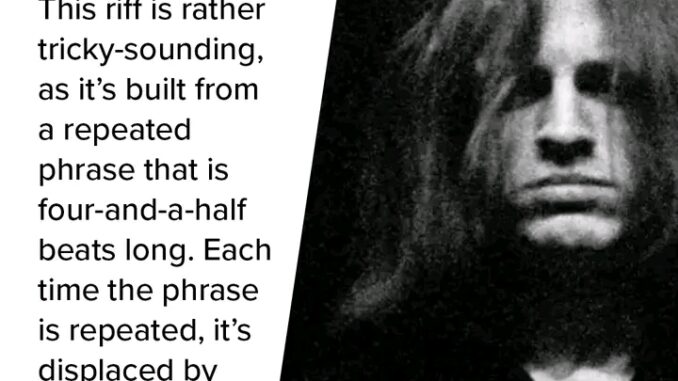
No matter how hard we may try to play it as accurately as possible, sometimes a classic guitar riff never ends up sounding quite like the official version, and Led Zeppelin’s “Black Dog” riff is certainly no exception to this frustrating phenomenon. The song’s signature guitar line is loose, raucous, memorable, and a bear to play.
Led Zeppelin bassist John Paul Jones broke down the riff count-by-count in a 1996 column for Guitar World, revealing what most people get wrong about the iconic lick.
Certainly! Here’s a detailed 800-word exploration of Led Zeppelin’s “Black Dog” riff, inspired by John Paul Jones’s breakdown and the common pitfalls players encounter:
**Decoding the Riff: Why ‘Black Dog’ Is a Challenging Masterpiece**
Led Zeppelin’s “Black Dog” remains one of rock’s most iconic tracks—its riff instantly recognizable, rhythmically complex, and technically demanding. While many guitarists aspire to master the riff, it often sounds different from the classic recording, primarily due to subtle nuances in timing, finger placement, and feel. In 1996, bassist and arranger John Paul Jones provided a detailed count-by-count breakdown in Guitar World, shedding light on what many players misunderstand about the riff’s intricate construction.
**The Essence of the Riff**
At its core, “Black Dog” features a riff that’s loose, rhythmic, and almost improvisational in feel. It’s built around a repeating motif played on the low strings, with offbeat accents, slides, and muted strums adding to its raw energy. The challenge for guitarists is to replicate this feel precisely, capturing the groove while maintaining the technical accuracy.
**The Count Breakdown**
Jones’s detailed analysis reveals that the riff is not as straightforward as it appears. The rhythm is syncopated, with emphasis on the off-beats, and the timing is slightly ‘floating’—a deliberate looseness that gives the riff its swing and swagger. Here’s a simplified version of the count-by-count breakdown:
1. **Initial Pulse:** The riff begins with a slide into the fifth fret on the low E string (A note), emphasizing a laid-back, almost lazy feel. This slide is not sharply placed but is instead slightly delayed, contributing to the groove.
2. **Off-Beat Accents:** The key to the riff’s feel lies in accenting the off-beats—particularly the ‘and’ counts. Many players rush through these or neglect the importance of muting, which leads to a less authentic sound.
3. **Muting and Palm Muting:** Jones emphasizes the importance of palm muting the strings to produce a percussive sound. The muted strums act as rhythmic punctuation, keeping the groove tight.
4. **Slides and Pull-offs:** The riff features subtle slides and pull-offs that should be executed smoothly and rhythmically, not abruptly or rigidly.
5. **Timing of Notes:** The placement of notes slightly behind the beat is crucial. Many players try to play ‘on’ the beat, but the feel of the original recording relies on slight delays, creating a relaxed, heavy groove.
**Common Mistakes and Why They Happen**
– **Rigid Timing:** Many guitarists attempt to play the riff with perfect, metronomic precision. While discipline is essential, the relaxed feel of “Black Dog” demands a slight delay, almost as if the riff is swinging or swinging in a bluesy manner.
– **Neglecting the Muting:** Failing to palm mute or dampen strings results in a muddier, less punchy sound. The muted notes are vital for the percussive quality that drives the riff forward.
– **Incorrect Finger Placement:** Some players fret the notes too cleanly or miss the slides’ subtlety. The riff’s character depends on the roughness and slight imperfections that give it its attitude.
– **Playing Too Straight:** The original riff is loose, with slight variations in timing. Trying to play it perfectly in strict rhythm strips away its organic feel.
**Mastering the Feel**
To emulate the “Black Dog” riff authentically, guitarists should focus on:
– **Listening Deeply:** Absorb the groove by listening repeatedly to the original recording, paying close attention to the rhythm, muting, and slide nuances.
– **Practicing with a Metronome:** Use a slow metronome, then gradually loosen the timing to match the feel. Don’t aim for perfection—aim for groove.
– **Experimenting with Muting:** Practice palm muting and damping strings to get the percussive sound right.
– **Playing with Feel:** Emphasize the off-beats and allow slight delays in your timing. Remember, this riff is about groove, not mechanical precision.
**The Takeaway**
Led Zeppelin’s “Black Dog” is more than just a riff; it’s an exercise in feel, groove, and attitude. John Paul Jones’s breakdown underscores that the song’s power lies in its looseness and rhythmic complexity. The “wrong” way to play the riff is to ignore its subtle timing variations and muting techniques. Instead, aspiring players should focus on capturing its soulful, swinging feel—embracing imperfection to find the magic.
In the end, no matter how many times you practice, capturing the true essence of “Black Dog” requires listening, feeling, and sometimes—letting go of rigid timing. When you do, the riff can truly come alive, resonating with the raw energy that made it a rock classic.
If you’d like, I can help you with a detailed tab, or suggest exercises to master this iconic riff!
Leave a Reply